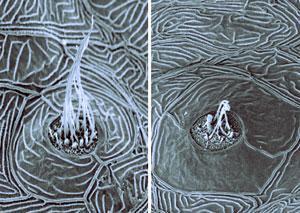
© Rockefeller UniversityAll ears. Electron micrographs of two hair cell bundles in the zebra fish ear show the difference between those born with (left) and without (right) the protein Tmie.
A serendipitous discovery of deaf zebra fish larvae has helped narrow down the function of an elusive protein necessary for hearing and balance. The work, led by Rockefeller University's A. James Hudspeth, suggests that
hearing loss may arise from a faulty pathway that translates sound waves into electrical impulses the brain can understand.
"These zebrafish larvae were originally pegged for another study, but then we saw that one-fourth of them failed to respond to acoustic stimuli and made erratic spiraling movements,
and that suggested that they were born deaf," says first author Michelle R. Gleason, who spearheaded the project. "So we took this opportunity to examine what could be responsible for this extreme hearing loss."
At first, Gleason and Hudspeth, head of the Laboratory of Sensory Neuroscience and a Howard Hughes Medical Institute investigator, didn't detect any structural defects in the zebra fish's inner ear, which houses sound sensors called hair cells.

Comment: 2029? How about the other NEO's that can come at any time? Sounds like they are practicing for something sooner!